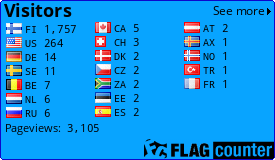THE ROCK-MONUMENTS OF SVEKOFENNIDIES 1- (BLACK MOUNTAIN) MUSTAVUORI'S ”DEVIL'S HEAD”
[ENG] The Earthcache of this is meant to introduce the ancient Svekofennidies part of Black Mountain (Mustavuori) ice age's sculpted rocky wall in north-eastern Äänekoski, nearby Ruotinkylä village, a most unusual monument of the ice age is a lion's head or the devil-like rock formation on the western mountain's rocky wall.
Svekofennidian mountain has been formed 1.9 billion years ago and it was similar as the existing Alpine foldmountains. The ancient land of this mountainous region were also volcanoes which explains something of the region's stone types that you can see here today like tuffites and amphibolite which has formed from volcanic ash and lava. Svekofennidian mountain range was started from southern Finland and went to the Swedish side up, and from them aren´t currently left than the deep bottom parts that are not more than 200 feets high.
The Svekofennidian mountains bedrock called svekofennish schist zone. Current South and Central Finland's bedrock has formed at the same time, in the same context of Svekofennidian mountain what tells that our bedrock is really old and it has been born from the mantle of earth stone materials and thus it is of volcanic origin.At the born during of this mountain range to the crust of earth upper stratum arrived the genus of deep granite rocks, which are the predominant rock types present in central Finland's bedrock.
The Ice Ages has sanded as the same way as in Eastern-Finland situated Karelidies also Svekofennidian foldmountains to current form flat top hill areas.Black Mountain's devil´s head or lion's head reminding like a rocky wall protrusion was born as Ice sanded and eroded rocky wall during the Ice Age and Ice Age's after frost weathering is still edited by the details, when it has born like a lion's head resembling rock structure known as body rock or body stone. The most common types of body rocks is human or bear heads resemble slots. You can park your car carefully to Mustaniementie- roadside near the leading trailhead of Black Mountain which is marked to waypoints of this earthcache.
Tasks on earthcache visitors:
1. Guess in the zero point spot what else traces ice masses and frost weathering has lived frontside of this body rock?
2. Tell me your image from the cliffs which would have they looked like before the last Ice Age 115 000 years ago?
3. Send your answers to the owner for example via Message Center. You can log the cache after you have sent the answers. If there's something wrong, we will contact you.
4. Voluntary task: if you took a camera to your nature-trip and you want to take a picture from yourself and your gps, would you please take it so that "Devil´'s head" body rock appears background of you. You can send your picture to the owner or upload it in your log.
Have a Nice Earthcaching day! 

[FIN] Tämän earthcachen on tarkoitus esitellä muinaisiin Svekofennideihin kuuluvan Mustavuoren jääkauden veistämää kalliojyrkännettä koillis-Äänekoskella lähellä Ruotinkylää, jonka erikoisin jääkauden monumentti on leijonan tai paholaisen päätä muistuttava kalliomuodostuma vuoren läntisellä kallioseinämällä.
Svekofenniidien vuoristo on muodostunut 1900 miljoonaa vuotta sitten ja se oli nykyisten Alppien kaltainen poimuvuoristo. Tällä muinaisella vuoristoalueella oli myös tulivuoria joista kertoo eräät tänäkin päivänä alueella tavattavat kivilajit kuten tuffiitit ja amfiboliitit jotka ovat muodostuneet tulivuorten tuhkasta ja laavasta. Svekofennidien vuorijono kulki eteläisestä Suomesta aina Ruotsin puolelle asti ja niistä ei nykyään ole jäljellä enää kuin syvät juuriosat jotka ovat korkeintaan 200 metriä korkeita.
Svekofennidien vuoriston kallioperää kutsutaan svekofenniseksi liuskealueeksi. Nykyinen Etelä ja Keski-Suomen kallioperä on muodostunut samaan aikaan Svekofennidien vuorijonon yhteydessä eli kallioperämme on todella vanhaa ja se on syntynyt maan vaipan kiviaineksista ja on täten vulkaanista alkuperää. Tämän vuorijonon syntyaikoina maapallon kuoren yläosiin pääsi graniitin sukuisia syväkivilajeja, jotka ovat vallitsevia kivilajeja nykyisen Keski-Suomen kallioperässä.
Jääkausi hioi Itäisessä Suomessa sijainneiden Karelidien tapaan myös Svekofennidien poimuvuoret nykyisenlaisiksi laakealakisiksi mäkialueiksi. Mustavuoren pirunpäätä tai leijonanpäätä muistuttava kallioseinän ulkonema on syntynyt jäätikön hioessa ja kuluttaessa kallionjyrkännettä jääkauden aikana ja jääkauden jälkeen pakkasrapautuminen on vielä muokannut yksityiskohtia, jolloin on syntynyt leijonanpäätä muistuttava rakenne jota kutsutaan hahmokallioksi tai hahmokiveksi. Hahmokivien ja hahmokallioiden yleisimmät muodot ovat ihmisen tai karhunpäätä muistuttavat paikat.
Auton voi parkkeerata varovasti Mustaniementien sivuun lähelle Mustavuorelle lähtevän polun alkupäätä josta reittipiste tässä kätköselostuksessa.
Tehtäviä geokohteella vierailijalle:
1. Arvioi nollakoordinaateissa paikan päällä, mitä muita jälkiä jäämassat ja pakkasrapautuminen ovat saaneet aikaiseksi tämän hahmokallion edustalla.
2. Kerro mielikuvasi, miltä alueen kalliot olisivat näyttäneet ennen viimeisintä jääkautta 115 000 vuotta sitten?
3. Lähetä vastauksesi kätkön omistajalle esimerkiksi Message Centerin kautta. Kun olet tämän tehnyt, voit logata kätkön löydetyksi. Jos vastauksessasi on jotain korjattavaa, otamme yhteyttä.
4. Vapaaehtoistehtävä: mikäli otit kameran luontoretkellesi mukaan voit halutessasi ottaa kuvan itsestäsi ja gepsistäsi niin että nollapisteessä suoraan edessä näkyvä ”pirunpää” hahmokalliomuodostelma näkyy taustallasi.
